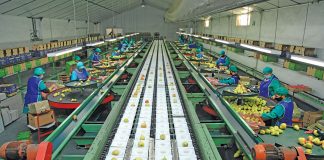Jatropha is a hardy, high oil content crop with serious potential for biodiesel production in South Africa. But as it is classified as a noxious weed, large-scale cultivation has also raised environmental concerns. Chesney Bradshaw investigates the merits and drawbacks of jatropha as a possible employment driver that holds no threat to food security, as is the case with other biodiesel crops.
Jatropha is called the “biodiesel tree” as it flourishes in the wild and produces high levels of oil, even in arid areas.
Developing nations such as India and many countries in – Zimbabwe and Zambia are the main growing areas with Mozambique and Swaziland fast catching up – have led the oil rush to develop its potential as an alternative renewable fuel and job creator among the rural poor. But these developments are so new that fairly little is known about its risks under cultivation.
Although jatropha is mainly grown by small-scale rural farmers, demand for biodiesel could reach a threshold where it could not be met by these farmers alone. But before farmers rush into large-scale commercial plant and invest millions, they need reassurance on two main counts.
First, jatropha still needs to be assessed for its environmental impact and government approval needs to be obtained for large-scale commercial plantation. Second, farmers need to know how vulnerable it is to plant diseases and pests. A wide range of positive qualities Jatropha curcas, also known as the physic nut because of its purported medicinal uses for diseases like cancer, piles, snakebite, paralysis and dropsy (swelling), grows wild in poor low nutrient soil. It originated from Mexico and Central America and was introduced as a hedge plant to Africa and Asia. decidious tree, it grows between three and five metres high but can attain heights of eight to 10 metres under favourable conditions. Jatropha is easy to establish as it does not require fertile soil, extensive irrigation or much fertilisation. It is frost hardy and takes about two years to bear fruit, but research by the KZN Department of Agriculture and Environmental Affairs has shown that some plants bear fruit after 18 months.
Biodiesel producers favour jatropha because it has higher oil yields than crops such as sunflower, soya, peanut or rape seed. perennial with up to three harvests a year, jatropha can yield up to 1 600 litres/ha of non-edible oil a year. “Jatropha curcas is the higher yielding of most oil crops. It is a non-edible oil that will not infringe on food security,” says Gjalt Hooghiemstra, chief agronomist of D1 Africa, a subsidiary of – a UK-based global biodiesel producer. iodiesel from jatropha produces about 70% less carbon dioxide, lower sulphur dioxide and exhaust smoke emissions than fossil fuels. Biodiesel processing produces numerous by-products, such as nitrogen-rich press cake and glycerol for fertiliser, a base for soap and cosmetics, and the seed husks can fuel generators.
However, the seed cake cannot be used as a protein source for animals as it contains toxic chemicals. The challenges of production Lack of government approval for growing the crop presents the most serious barrier to production. Darryl Melrose, owner of Biodiesel SA and local biodiesel pioneer, laments this hesitation. “Unfortunately we have not progressed over the last two years on the production of jatropha diesel due to the banning of commercial growing of jatropha.” Yet there has been government interest in jatropha for biodiesel. After senior KZN agriculture department staff visited biodiesel plants in Germany in 2003, KZN’s minister of agriculture and environmental affairs Dumisani Makhaye was optimistic that a biodiesel refinery would be established in the province.
The fear is that if grown on a commercial scale jatropha may become invasive. The plant is a declared noxious weed in parts of Australia and is classified as a weed in several other countries. But some environmentalists believe that jatropha crops under controlled plantation management would not pose a threat. For years farmers worldwide have planted jatropha as a hedge to prevent entry by livestock. The tree is not propagated by birds or animals mainly due to its toxicity.
D 1 Oils Africa submitted an Environmental Impact Study (EIA) in November 2005 for rural land in southern KZN, but it has not received a response from the agriculture department. Legislative changes in SA, however, may introduce compulsory biodiesel blends into fossil diesel by 2007. If jatropha is approved, D1 Oils Africa aims to establish plantations of jatropha as its feedstock of choice throughout Southern Africa. Hooghiemstra says there is much interest from farmers and institutions in SA.
Although some environmentalists are concerned about land conversion – diverting land from food production – jatropha can be grown on marginal land because it is a hardy tree. For example, a rail line in India is planted with jatropha. The train runs on biodiesel. “Jatropha should be grown in areas unsuitable for normal food crops such as on hillsides, rocky areas and arid regions,” says Melrose. Diseases and pests – the potential threat The potential for diseases is a deterrent to cultivation. Both environment and crop management influence the performance of a new crop such as jatropha.
Professor Wijnand Swart, plant pathologist and chairperson of the Centre for Plant Health Management at the University of the Free State, says climate and biotic factors such as fungi, bacteria and insect pests can present significant threats to new crop cultivation. “Under intensive cultivation in arid regions, crops newly introduced into SA can provide a ‘green oasis’ of food for pathogens and insects,” he says.
According to Swart, powdery mildew is a commonly reported fungal pathogen of jatropha in other parts of the world. In Zimbabwe, the fungal disease frog-eye kills the jatropha leaves, preventing the plant from feeding itself through photosynthesis. In India, where jatropha is extensively cultivated, research into diseases is embryonic. “At this time we only know of a few fungal, bacterial and insect-related problems that can be a potential threat to the commercial cultivation of jatropha,” says Dr Sudheer Shetty, managing director of Labland Biotech Private in India. Plant diseases that invade jatropha, says Swart, can be mitigated through pest management practices such as pruning, sanitation and removing dead material. Chemical and biological methods are being tried in India but it’s too early to reach any conclusions.
Hooghiemstra says D1 is investing in crop improvement through breeding and training. “We have trained over 40 farmers in Swaziland on how to plant and manage the crop and are training farmers in Zambia.” D1 Oils’ EIA reports that 14 species of invertebrates feed on the fruit both in the paleotropics (tropical regions of Africa and Asia) and the neotropics (Central and Southern America and the Caribbean). Other possible pests are a species of stem borer, grasshoppers, leaf-eating beetles, caterpillars, leafhoppers and millipedes.
Another issue under consideration is water use. The Water Research Commission has launched a three-year study into the water resource-related impacts of large-scale planting of Jatropha curcas at two sites in KZN. Major benefits for South Africa Despite these concerns about jatropha production, there are major benefits to be realised in producing a renewable energy crop for biodiesel. Interest from international companies is high. For example, British Petroleum is investing 4 million in a jatropha-based biodiesel feasibility study in Andhra Pradesh, India.
Daimler-Chrysler in India has successfully run a Mercedes-Benz C 220 CDI modified to use jatropha biodiesel on a 5 900km trip through the country. Jatropha-produced biodiesel is not yet used in vehicles in SA, says Hooghiemstra. “We are awaiting the strategy for the biofuels industry in SA which will stipulate blend percentages. It should be finalised by May 2007.” Reducing global climate change means confronting various challenges. Among these are how to reconcile the trade-offs between, for example, job creation and land conversion. SA must find alternative renewable fuels for the future. Jatropha could make a major economic and more pollution-free energy contribution, but farming practices must be rigorously and scientifically controlled. For more information e-mail Caren Cupido from D1 Oils Africa at [email protected]; or e-mail Darryl Melrose from Biodiesel SA at [email protected]. |fw













